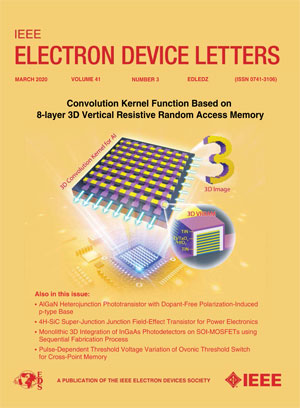Impact of Al-Doping on Ferroelectricity and Reliability of HfZrO Film Under High Temperature Annealing
IF 4.5
2区 工程技术
Q2 ENGINEERING, ELECTRICAL & ELECTRONIC
引用次数: 0
Abstract
This study explores the influences of Al-doping on a ferroelectricity and a reliability of Hfal掺杂对高温退火下HfZrO薄膜铁电性和可靠性的影响
本研究探讨了al掺杂对高温退火Hf ${}_{{0}.{5}}$ Zr ${}_{{0}.{5}}$ O2 (HZO)薄膜铁电性和可靠性的影响。采用原子层沉积(ALD)超循环法制备了Al2O3 (AlO)层均匀掺杂于HZO薄膜中的Al:HZO薄膜。所有Al:HZO薄膜均表现出泄漏电流减小,击穿场增大,10年寿命电压(> 2.32 V),寿命(> $10^{{10}}$ cycles),无明显的疲劳和唤醒效应。在Al:HZO薄膜中,72:1的循环比(CR)显示出$\boldsymbol {\sim } 22.7~\boldsymbol {\mu }$ C/cm2的最高剩余极化(${P}_{\text {r}}\text {)}$),而36:1的循环比(CR)提供了可靠性与${P}_{\text {r}}$ ($\boldsymbol {\sim } 19.1~\boldsymbol {\mu }$ C/cm ${}^{{2}}\text {)}$)之间的最佳权衡。这些结果表明,Al:HZO薄膜是下一代3D铁电存储器应用的有希望的候选者,需要高热预算兼容性和强大的可靠性。
本文章由计算机程序翻译,如有差异,请以英文原文为准。
求助全文
约1分钟内获得全文
求助全文
来源期刊

IEEE Electron Device Letters
工程技术-工程:电子与电气
CiteScore
8.20
自引率
10.20%
发文量
551
审稿时长
1.4 months
期刊介绍:
IEEE Electron Device Letters publishes original and significant contributions relating to the theory, modeling, design, performance and reliability of electron and ion integrated circuit devices and interconnects, involving insulators, metals, organic materials, micro-plasmas, semiconductors, quantum-effect structures, vacuum devices, and emerging materials with applications in bioelectronics, biomedical electronics, computation, communications, displays, microelectromechanics, imaging, micro-actuators, nanoelectronics, optoelectronics, photovoltaics, power ICs and micro-sensors.
 求助内容:
求助内容: 应助结果提醒方式:
应助结果提醒方式:


